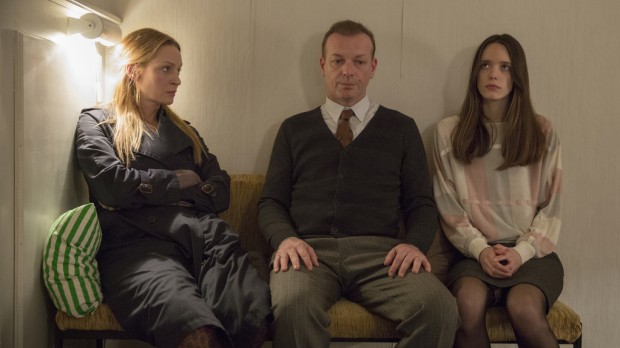
Although we’ve long thought of this as a Charlotte Gainsbourg-led picture, the true star of Nymphomaniac: Volume I — and, if early looks should be any indication, still taking a big role in the second half — is Stacy Martin, a French-English model with enough humility to make the center of Lars von Trier‘s lengthy, no-holds-barred sex odyssey her acting debut. The task seems almost insurmountable and the requirements might make one’s head spin, but in the first two hours does she give the craft everything as emotions, the body, and an internal thespian psychology find themselves splayed across the screen.
Many questions will naturally arise after seeing the work for oneself, and it’s below where the actress and I discuss expectations, extreme tonal balance, shooting extensive sex scenes (including some curious qualifications), and how von Trier gets his actors to work through a scene. Read on:
The Film Stage: It’s funny, because I’m speaking with you about a performance I haven’t even seen all of. I know that, overseas, the situation is different, but is it strange to promote half a film in the United States?
Stacy Martin: [Laughs] I mean, it’s… I haven’t seen the version that’s coming out in America, so is it that different? I have no idea. I’m very curious to see how Americans react — especially, as well, because it has so many American, massive Hollywood stars. I’m really curious and quite excited, to be honest.
 I’d seen Volume I with others — others who reacted rather positively — and watching with different reactions floating around offered an unusual experience. It’s a very funny work, but quite sad and quite dark, the particular example, for me, being your encounter with Uma Thurman’s Mrs. H. I feel as if an entire ten-minute interview could be orchestrated around that — so, when shooting such a scene, what is the on-set tenor? How does Lars make it work?
I’d seen Volume I with others — others who reacted rather positively — and watching with different reactions floating around offered an unusual experience. It’s a very funny work, but quite sad and quite dark, the particular example, for me, being your encounter with Uma Thurman’s Mrs. H. I feel as if an entire ten-minute interview could be orchestrated around that — so, when shooting such a scene, what is the on-set tenor? How does Lars make it work?
He just lets you get on with it. Lars is quite unique in his way of directing, in that he really lets his actors come up with ideas and come up with their own versions, and then he can mold that into whatever he’s looking for. For a scene like this, with the incredible performance by Uma Thurman, she really took the challenge of it all — and when you have amazing actors like that, suddenly, you are in the scene. All the amount of preparation that you’ve done, suddenly you don’t think about it all, because you’re there; actors like Shia LaBeouf or Christian Slater, they do exactly that, and it doesn’t become work.
It’s completely effortless and it’s very difficult, because your heart goes out completely to this woman who’s a complete mess, but, because of the character, I’m sort of forced to not empathize with her, to not like her — and that’s difficult, because it’s so contrary to who I am as a person. But it was also very funny, and it came out a lot filming it, when you realize, “No one’s helping her, she’s bringing the children, she’s not shutting up.” It’s crazy. [Laughs]
Does von Trier key you into his specific processes before shooting begins, or does he let you discover that while things are actually underway?
You discover it. It was a little surprise, because he arrives on set, he doesn’t… and I think this is quite new, because I was talking to Stellan [Skarsgård], and he said that Lars used to control a lot of the things — every movement of the actors was controlled — and, now, he sort of lets you improvise. He doesn’t block, but you find that on-set, in the morning: he’ll come and say hi to you, and then he goes, “Okay, let’s start.” Then he says “action,” and you’re going, “Oh, okay.” So it takes a few minutes to go, “Okay, this is how it is.” And, you, as an actress, suddenly your head kicks in, and you go, “Okay, right. That’s this way.” It’s fascinating.
You had body doubles employed for many of the scenes, yet I forgot, watching the actual film, that such a thing had even been done.
Yeah, I forgot watching it as well. I was so shocked; it looks so real. Thinking, “I don’t remember doing that!” [Laughs]
So I have to ask: are you performing anything in those scenes, or is that all a body double with your face grafted on? Honestly, it’s rather difficult to tell.
It is, isn’t it? Basically: everything is mine, but the special parts. Let’s say “vagina”; I don’t know why I’m trying to find new ways to say “vagina.” So, we would both do the scene and he would actually have people have sex, basically, and I went in for amazing CGI work. But anything that’s actually sexual… yeah, that’s not me.
You’ve just spoken about the process in shooting a dialogue scene with von Trier, so I’m left to wonder if the same applies for this physical work.
No, not at all. That was the complete opposite, because it had to be — just because of CGI — we really needed to know, we needed to sort out the positions because of the angles, because of the visual effects people. Also, for me, I said to him, “I want to feel as comfortable as possible doing this scene. Knowing that I have a porn double and knowing that I have a prosthetic, that’s one step, but I want to know what we’re doing.” I needed that kind of structure; it was very important. So, it was almost like doing a dance routine — you do this, you do that, click, click, click. You find your way through it.
How do you speak with a co-star, actor-to-actor, before doing that?
What was great with Shia was that we had time to get to know each other. We met before filming, and that was very important. Sometimes, we just didn’t; there was a time, I think we did a whole day, and it was just the smaller sex scenes. Then, suddenly, you know, it’s completely impersonal — it’s just, “Okay, let’s do this, let’s do that.” I think it kind of mirrors, as well, Joe and her character, and I kind of used that as well. I said, “Well, great. This is a gift for understanding where she’s coming from and what she’s doing, all those things.”

You’ve seen the complete project, I’m sure.
Yeah.
When you go to a place like Berlin, watching it with a big crowd… could you recount the experience of that, and how it might prove strange?
[Berlinale] was the first time I watched it in a cinema — with an audience, with Lars, and with the cast. It was… you know, I’d seen the movie before. I knew what I was watching, but the great thing about this film, that I realized, with all the digressions you’re constantly looking at them, sort of remembering things. “Oh, I forgot that!” It’s so dense. To see the reactions of the audience — how they were laughing — and to sort of be there with Lars, I was so proud for him and just so happy and really excited, as well. I mean, I felt very protective.
And you get to learn about fly fishing, too.
Yeah, I mean, don’t bother with all the sex — you get to learn about fly fishing.
I was surprised, after seeing the film, that this is your first real onscreen performance. I say it as a compliment, truly, though it forces me to ask if you see this as… when you get this kind of role, do you see it as a good start to a film career, or is it a bit of a digression from modeling work?
Well, it’s definitely a beginning — it’s my first film, first part, first job in a career that I really value and want to do. But, for me, when I read the script, there was no way I wasn’t going to do it. I just see it more as showing the world and, especially, the industry that I’m not afraid of taking on a challenge, and I’m not afraid of taking parts that will prove to be difficult, and might not be appealing for everyone. But that’s the exact kind of work that I love doing — getting parts that are really difficult and, you know, they’re not always difficult because of the nudity. You have a lot of difficult and heavy parts out there and that’s how I see it. So, that’s how I’m attracted to it.
Both Nymphomaniac: Volume I and Volume II are currently available on VOD; the first half is now in theaters, while the second makes its theatrical debut on April 4.

